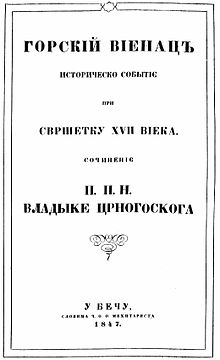The mountain wreath

Facsimile of the print Vienna 1847
|
The Mountain Wreath ( Montenegrin : Горски вијенац / Gorski Vijenac ; Slavonic-Serbian Горскıй вıенацъ) is penned in verse epic and is, as the title expresses, as a historical witness of the era of the first Prince Bishop Danilo late 17th century in the region around Montenegro. The author was Petar II. Petrović-Njegoš , who ruled as Prince-Bishop of Montenegro from 1830 to 1851.
history
His magnum opus , which was largely written down by him in Cetinje in 1846 , is considered to be one of the most important works of Montenegrin literature. The first print was published in Vienna in 1847. The prince-bishop took his transcript with him on a diplomatic mission to Vienna, where he left it to the local Armenian monastery for printing. Due to his priority mission to ask Russia for assistance in the fight against the Ottomans , he could only skim the finished print. There must have been some inconsistencies in printing and the text was changed, albeit to a very minor extent. The first edition from 1847 is considered to be largely authentic because the author died of tuberculosis only four years later after a long cure and illness and there is no official standard edition.
construction
dedication
The author , who addressed the dedication with the description to the dust of the father of Serbia (Праху отца Србіе) to the deceased Karađorđe , had to replace some of his text with placeholders due to the censorship requirements of the Austro-Hungarian Empire. About one third of the dedication text fell victim to censorship.
Dramatis personae
The following characters are listed; Original text:
|
|
The following characters appear in the epic, but are not mentioned in the dramatis personae :
- Vuk Marković
- a cuca (a member of the Montenegrin tribe of the Cuce)
- a soldier
- a second soldier
- a Montenegrin wedding guest
- a Turkish wedding guest
chapter
The epic is divided into four chapters of different lengths:
- Assembly on Mount Lovćen (verses 1 to 197)
- Assembly in Cetinje (verses 198 to 2.437)
- Christmas Eve (verses 2.438 to 2.665)
- New summer (verses 2.666 to 2.819)
evaluation
Njegoš 'Bergkranz is the main work of South Slavic poetry of Romanticism, which in the canon of Serbian literary history represents the extreme expression of patriotic spirit and philosophy based on popular belief and the tradition of heroic epics. Antun Barac emphasized the importance of the mountain wreath as follows:
“Derived from the people, the contemporary conditions in Montenegro and among all Serbs, this work is at the same time the most comprehensive and humane work of Serbian literature. At the time when the foundations of the new Serbian literature in the struggle for a new language and a new spirit were laid on the traditions of older Serbian literature and on the elements of folk poetry, the Gorski vijenac is its perfect completion. It's a mix of perfect simplicity, precision, and depth, with folk elements; and just as personal from start to finish. "
In the course of the increasing enthusiasm for folk creation in Southeast Europe, the first German translation was created in 1886. After that, the work received little attention in Germany until the interwar period. Alois Schmaus made it known in Germany.
literature
Der Bergkranz, single editions
Serbian
- Горскıй вıенацъ. Facsimile of the first print from 1847, publisher Muzeji Cetinje. Cetinje 1984, Druck Forum, Novi Sad, print run: 10,000.
English
- The Mountain Wreath. first translation into English, translator James W. Wiles. George Allen & Unwin, London 1930.
- The Mountain Wreath. 2nd revised edition. Translator Vasa D. Mihailovich. Serbian Europe, Belgrade 1997 (Serbian and parallel to it in English). (1st edition translator Vasa D. Mihailovich 1987.)
German
- The mountain wreath. Introduction, translation and commentary by A. Schmaus. Munich 1963, new edition Munich 2012 (eBook, pdf), ISBN 978-3-95479-625-0 .
Secondary literature
- <Koljević, Gorski vijenac> Svetozar Koljević (1993): Smrt Epa u Gorskom vijencu . Matica Srpska, 169.1 = Kn. 451.1 / 6. 1993, Novi Sad.
swell
- Excerpts from "Der Bergkranz" (German translation) on the website of the University of Klagenfurt.
- The Mountain Wreath, translation Vasa D. Mihailovich 2nd edition, Belgrade 1997 (English).
- Rastkoprojekt: Горски Вијенац (mountain wreath ) (Serbian, Cyrillic script).
- Metropolis of the Serbian Orthodox Church: Gorski Vijenac (Serbian, Latin script).
- The Mountain Wreath with further explanations, translation by James W. Wiles 1930 (English).
Individual evidence
- ↑ a b Tomislav Longinović: Old Men Singing: Heroic Masculinity among “the serbs”. In: Philip V. Bohlman , Nada Petković: Balkan Epic - Song, History, Modernity . The Scarecrow Press, Lanham 2012, ISBN 978-0-8108-7799-3 , p. 250.